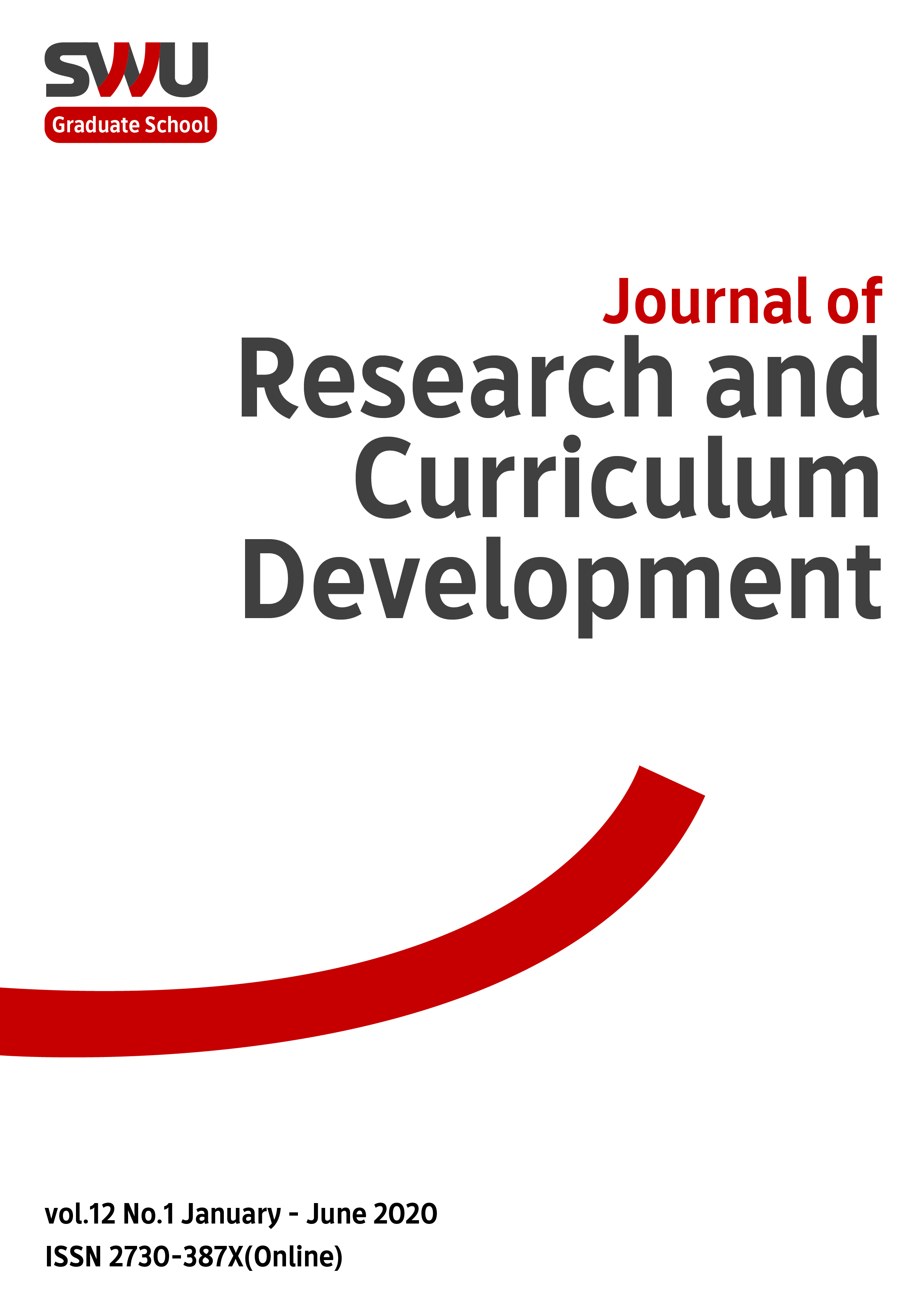Study of Professional and Self-Development, Teacher Efficacy and Resilience Quotient among Beginning Teachers Who Studied under the Patronage of Her Royal Highness Princess Maha Chakri Sirindhorn
Keywords:
Professional and self-development, Teacher efficacy, Resilience quotientAbstract
The aims of this research are as follows: (1) to study the professional and self-development, teacher efficacy, and resilience quotient among beginning teachers who studied under the Patronage of Her Royal Highness Princess Maha Chakri Sirindhorn and worked in rural schools or in remote rural areas; and (2) to compare professional and self-development, teacher efficacy, and resilience quotient for beginning teachers who studied under the Patronage of Her Royal Highness Princess Maha Chakri Sirindhorn, with differences in gender, major, number of teaching years, school type, teaching characteristics, subjects taught, and number of teaching hours per week. The sample consisted of 113 beginning teachers who studied under the Patronage of Her Royal Highness Princess Maha Chakri Sirindhorn and worked in rural schools or remote rural areas from four generations and selected by the simple random sampling technique.The research tools were three sets of a six point rating scale (0-5 points) which included the following: (1) 24-items on professional and self-development; (2) 24-items on teacher efficacy; and (3) a 42-item on resilience quotient. The reliability of these tools was high, with an overall alpha coefficient score of 0.986, 0,919 and 0.992. The statistics for data analysis were descriptive statistics, a Mann-Whitney U Test, and a Kruskal Wallis Test. The results of study revealed that:(1) professional and self-development, teacher efficacy, and resilience quotient among beginning teachers who studied under the Patronage of Her Royal Highness Princess Maha Chakri Sirindhorn were at a high level as teacher efficacy at the highest level (M=4.20, SD=.05) followed by resilience quotient (M=3.63, SD=.86) and professional and self-development (M=3.54, SD=.96), respectively; and (2) beginning teachers with teacher efficacy had a different number of teaching years had different levels of professional and self-development, resilience quotient, and different school types.
References
Bakar, A.R., Mohamed, S., and Zakaria, N.S. (2012). They are trended to teach, but how confident are they? A study of student teachers’ sense of efficacy. Journal of Social Sciences. 8(4), 497-504.
Bedia, G. (2015). Perception of teaching efficacy by primary and secondary school teachers. International Electronic Journal of Elementary Education. 8(1), 41-54.
Chotika Kangsanan. (2021). Educational connections from primary education to secondary education. Journal of Mahachunakonthat. 8(9), 34-46.
Department of Mental Health. (2020). Change Bad to Good. (online). from https://www.dmh.go.th/covid 19/
Doghonadze, N. (2016). The state of school and university teacher self-development in Gorgia. International Journal of Research in Education and Science. 2(1), 103-113.
Eisenman, G., & Thornton, H. (1999). Telementoring: Helping new teachers through the first year. T.H.E. Journal. 26(9), 72-82.
Gavora, P. (2010). Slovak pre-service teacher self-efficacy: Theoretical and research considerations. The New Educational Review. 21(2), 17-30.
Huling-Austin, L., Odell, S.J., Ishler, P., Kay, R.S. & Edelfelt, R.A. (1989). Assisting the Beginning Teacher. Reston, Va.: Association of Teacher Educators.
Jenson, B., Sandoval-Hemandez, A., Knoll, S., and Gonzalez, E.J. (2012). The Experienceof New Teachers: Results from TALIS 2008. from OECD Publishing http://dx.doi.org/10.1787/9789264120952-en.
Krejcie, R.V. and Morgan, E.W. (1970). Determining sample size for research activities. Educational and Psychological Measurement. 30, 607-610.
Martinez, R.S. (2003). Impact of a graduate class on attitudes toward inclusion, perceived teaching efficacy and knowledge about adapting instruction for children with disabilities in inclusive settings. Teacher Development. 7(3), 473-493.
Nisa Laheem and Suntree Wannaphairau. (n.d.). Compliance with Professional Standards of Teachers under Satun Primary Educational Service Area. (online). from
http://www.hu.ac.th/conference/proceeding/
Office of Personnel and Legal Management System Development. (2021). Project to Improve the Quality of Life and Professional Advancement of the New Generation of Teachers under the Royal Patronage. (Kruwattanawithi Project). (online). From https://personnel.obec.go.th/home/archives/48639. (Retrieved on May 26, 2021)
Polat, D.D. & Iskender, M. (2018). Exploring teachers’ resilience in relation to job satisfaction, burnout, organizational commitment and perception of organizational climate. International Journal of Psychology and Educational Studies. 5(3), 1-13.
Prawit Eraworn. (2019). Research Report on Analysis of Needs to Support the Development of New Teachers in Remote Rural Schools. A Research Project on the Development of Quality of Life and Professional Advancement of New GenerationTeachers in Rural Schools Who Studied under the Royal Patronage of Her Royal Highness Princess Maha Chakri Sirindhorn.
Sariyildiz, G. (2017). Novice and experienced teachers’ perceptions towards self-initiated professional development, professional development activities and possible hindering factors. International Journal of Language Academy. 5(5), 248-260.
Smith, T.M. & Ingersoll, R.M. (2004). What are the effects of induction and mentoring on beginning teacher attrition? American Educational Research Journal. 41(3), 681-714.
Supamon Chansakul and Suchada Bowonkitiwong. (2017). Non-parametric statistics and their applications in nursing research. Eastern Asia University Academic Journal: Science and Technology. 11(1), 38-48.
Suweetha Rerkkasem, Titiporn Pitchakul and Orasa Kosonnantakul. (2008). Performance of Professional standards of teachers in private schools Phra Nakhon Sri Ayutthaya province. Journal of Graduate Education Valayalongkorn University under the Royal Patronage. 2(3), 107-118.
Tschannen-Moran, M. and Hoy, W.K. (2001). Teacher efficacy: capturing an elusive construct. Teaching and Teacher Education. 17(7), 783-805.
Tschannen-Moran, M., Hoy, A. and Hoy, W.K. (1998). Teacher efficacy: Its meaning and measure. Review of Educational Research. 68, 202-248.
Waraporn Erawan. (2010). Development of a Resilient Quotient for Graduate Students through the Linking Group Technique Mapping, MMI Interview, and Mmulti-method Analysis-2 levels. Doctoral Thesis in Educational Measurement and Evaluation, Faculty of Education, Chulalongkorn University.
Waraporn Erawan. (2020). A study of the relationship between participation in professional learning community with teacher efficacy on teaching and teacher ethics of students practicing teacher professional experience. Journal of Educational Measurement Mahasarakham University. 26, 214-224.
Wattana Suthornchai. (2021). The Rationale Behind the Development of 5-level Decision Criteria. (online) from https://www.bu.ac.th/knowledgecenter/executive_journal/
Wong, H.K. (2004). Induction programs that keep new teachers teaching and improving. NASSP Bulletin. 88(638), 41-54.
Downloads
Published
How to Cite
Issue
Section
License

This work is licensed under a Creative Commons Attribution-NonCommercial-NoDerivatives 4.0 International License.





